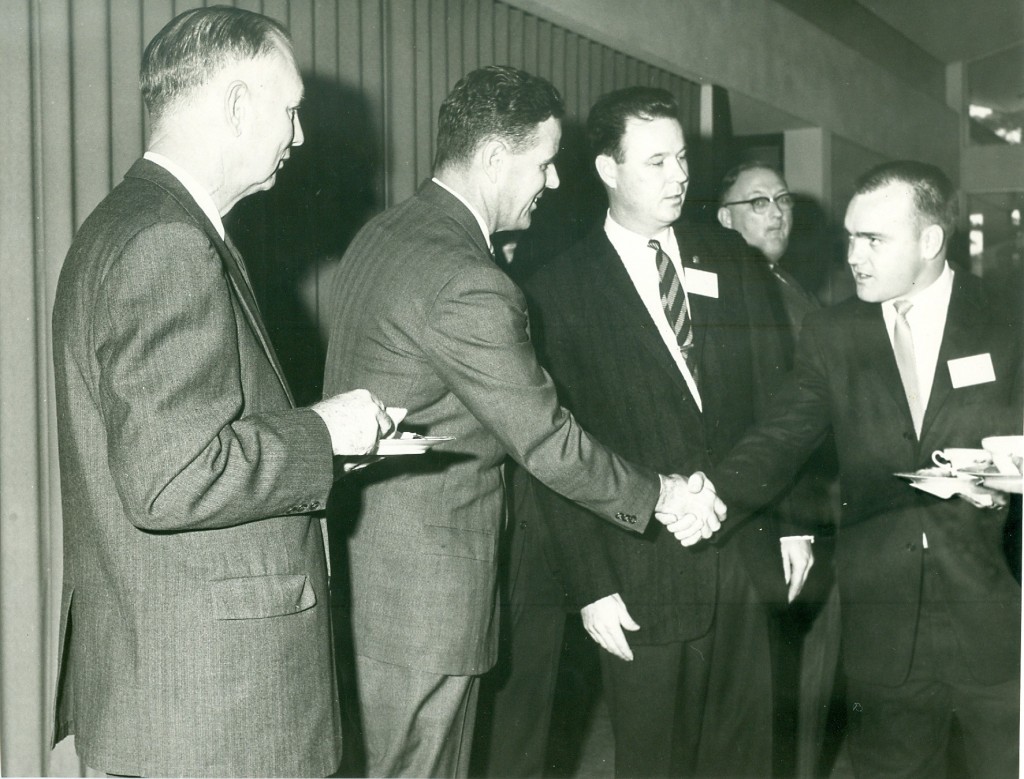Early years
In 1927, Little Rock Junior College opened to provide college-level courses to central Arkansas citizens who wanted and needed access to higher education. In its first year, “Jaycee” – as students would soon refer to the new college – met at Little Rock Senior High School and enrolled approximately 100 students paying five dollars per semester hour for the college’s two-year liberal arts program.
The early years of the new junior college were guided by the dreams and diligence of LRJC founder, John A. Larson (president, 1930-1950). Despite limited funding, Larson was determined to see LRJC flourish. In 1929, his aspirations for expanding the junior college were fulfilled when former Arkansas Gov. George W. Donaghey named LRJC as the sole beneficiary of a trust valued in excess of $2 million.

An increased commitment to public service marked the school’s growth over the next decades as LRJC continually found new ways to meet the community’s educational needs. For instance, the school responded to Little Rock’s employment demands by offering vocational instruction in areas such as surveying and pattern-making and educated non-traditional students through adult education courses in art history, sketching, and literature.
In 1957, the institution began a four‐year degree program, became independent and privately supported under a separate board of trustees, and took the name Little Rock University.Jaycee moved to its current location in 1949 after Little Rock businessman Raymond Rebsamen generously donated an 80-acre tract of land on Hayes Street. With a campus of its own and financial support from the Little Rock business community, LRJC thrived over the next decade – adding new buildings, increasing enrollment, and eventually outgrowing its junior college status.
Merger and expansion

After several years of discussion and study, Little Rock University in September 1969 merged with the University of Arkansas to create the University of Arkansas at Little Rock. That was a major step in the creation of a multi‐campus system that now includes eight campuses: University of Arkansas, Fayetteville; University of Arkansas for Medical Sciences; University of Arkansas at Little Rock; University of Arkansas at Pine Bluff; University of Arkansas at Monticello; Phillips Community College of the University of Arkansas; University of Arkansas Community College at Hope; and University of Arkansas Community College at Batesville. Within this structure, UALR is state supported, operationally separate, and specifically oriented toward serving the educational needs of Arkansas.
The University of Arkansas merger began a period of rapid growth, which saw UALR go from about 3,500 students and 75 full‐time faculty members in 1969 to more than 12,000 students and 500 full‐time faculty members today.
The University’s expanded offerings now include more than 100 undergraduate majors, an extensive schedule of night, weekend, and off‐campus classes, and a wide range of community educational services. UALR began offering graduate and professional work in 1975, and the UALR Graduate School was created in 1977.
Leadership
Presidents include R.C. Hall (1927‐1930), John A. Larson (1930‐1950), Granville Davis (1950‐1954), E.Q. Brothers (acting president 1954‐1956), and Carey V. Stabler (1956‐1969).
Chancellors of the University of Arkansas at Little Rock include Carey V. Stabler (1969‐1972), James H. Fribourgh (acting chancellor 1972‐ 1973, 1982), G. Robert Ross (1973‐1982), James H. Young (1982‐1992), Joel E. Anderson (interim chancellor 1993), Charles E. Hathaway (1993‐2002), Joel E. Anderson (2003‐2016), Andrew Rogerson (2016-2019), and Christina Drale (2019-).
Milestones
- 1927 Little Rock Board of Education established Little Rock Junior College (LRJC) upon the urging of Swedish-born principal John A. Larson. The college was located in Little Rock High School (now Little Rock Central High School) at West 14th and Park Streets.
- 1929 LRJC became the beneficiary of a trust established by former Arkansas Governor George W. Donaghey and his wife Louvenia.
- 1931 LRJC moved to the Uriah M. Rose Grammar School located at 13th and State Streets beginning with the fall term in September.
- 1949 LRJC moved to present location on an 80-acre tract of land on Hayes Street (now University Avenue) donated by Mr. Raymond Rebsamen.
- 1949 LRJC’s football team won Junior Rose Bowl in Pasadena, California.
- 1957 LRJC became the private Little Rock University (LRU) and began offering four-year degrees.
- 1969 Little Rock University merged with the University of Arkansas System to create the University of Arkansas at Little Rock (UALR).
- 1975 UA law program in Little Rock transferred to UALR and School of Law created.
- 1975 UA Graduate School of Social Work in Little Rock transferred to UALR.
- 1977 UALR Graduate School established.
- 1978 UA Industrial Research and Extension Center in Little Rock transferred to UALR.
- 1979 UALR joined the Trans-America Athletic Conference and began NCAA Division I competition.
- 1985 UA Little Rock Graduate Resident Center graduate programs in education transferred to UALR.
- 1986 UA Graduate Institute of Technology in Little Rock transferred to UALR.
- 1986 UALR Public Radio–KUAR-FM public radio went on the air.
- 1990 First UALR doctoral degree offered.
- 1991 UALR joined SunBelt Athletic Conference.
- 1992 First UALR student residence hall opened.
- 1995 UALR Benton Center opened.
- 1999 Donaghey College of Information Science and Systems Engineering (now Donaghey college of Engineering and Information Technology) established.
- 2000 UALR classified as doctoral university/research intensive in the National Carnegie categories of institutions of higher education.
- 2002 UALR celebrated its 75th anniversary.
- 2004 UALR purchased University Plaza Shopping Center on south end of campus at Asher and University Avenues.
- 2005 UALR opened on-campus intercollegiate athletic arena, a gift from Mr. Jackson T. Stephens.
- 2008 UALR launched its first comprehensive campaign, It’s Time for UALR.